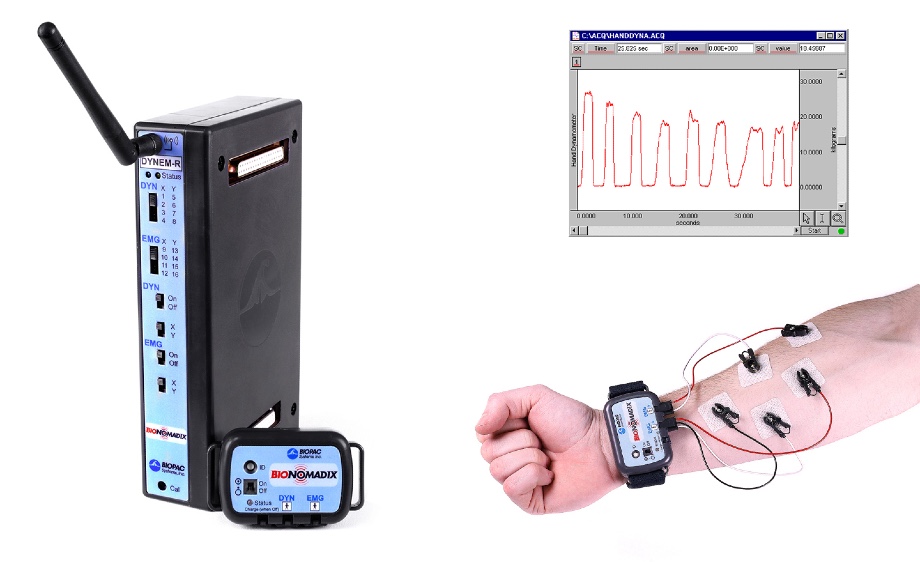Stationary Electrodermal Activity (EDA)
With Electrodermal Activity Assessment (EDA) we can collect metrics of physiological arousal triggered by the autonomic nervous system, and may reflect the general presence of an emotional arousing activity.
For conducting EDA in lab studies we possess wireless transmitter modules BioNomadixx from Biopac attached to the wrist of participants. These modules are wirelessly connected to the MP160 stationary acquisition unit (Biopac System Inc., https://www.biopac.com) via a local area network. At the participant’s hand and face, 15 cm electrode leads connected each transmitter module to 24 mm disposable hydrogel electrodes. EDA is then recorded and analyzed using the AcqKnowledge 5.0 from Biopac Systems. Alternatively, LedaLab, a Matlab-based software for analyzing skin conductance data (Benedek & Kaernbach, 2010), or opensource tools such as NeuroKit2, can be used.
Images below show the setup of EDA in our lab belonging to the GIVA (Geographic Information Visualization and Analysis) unit, located at the University of Zurich>'s Irchel campus, in the Geography department (room Y25-J86, tel: +41 44 635 52 80).

Technical Specifications
The technical setup of the staionary EDA consists of a wristband, a wirless transmitter and a data collection station with the following specifications:
BioNomdadix Receiver Modules & Transmitters
- Operational range: 10 meters (line-of-sight) typical in standard laboratory setups
- Delay: Fixed latency 15.6 ms and small variable component +/- 0.5 ms RMS
- Transmitter type: Ultra-low power, 2.4 GHz bi-directional digital RF transmitter
Rate: 2000 Hz (between transmitter and receiver)
BioNomdadix Logger
- Operational ange: 1 meter (line-of-sight, approx.)
- Transmitter type: Ultra-low power, 2.4 GHz bi-directional digital RF transmitter
- Rate: 2000 Hz, maximum screen: colour, 6 cm diagonal
- Memory: 8 GB
- Battery: 1800 mAh, Lithium-Ion battery
- Weight: 121.2 grams
- Charger operating time: acquisition 24 hours, standby ~30 days
MP160 Biopac
The BIOPAC MP160 system is a flexible, proven modular data acquisition & analysis system for life science research. This 16-channel system includes AcqKnowledge software with specialized analysis capabilities.
- Max Sample Rate, MP Internal Memory: 200 K samples/sec (400 K aggregate)
- PC Memory/Disk: 200 K samples/sec (400 K aggregate)
- Internal Buffer: 6 M samples
- Waveform Output Buffer: 500 K samples
- Serial Interface Type/Rate: Ethernet: UDP (10M bits/sec)
- Analog Inputs
- Number of Channels: 16
- A/D Resolution: 16 bits
- Accuracy (% of FSR): ±0.003
- Input impedance: 1.0 MΩ
- Analog Outputs
- Number of Channels: 2
- Max output with acquisition: 2 channels
- D/A Resolution: 16 bits
- Accuracy (% of FSR): ±0.003
- Output Drive Current: ±5 mA (max)
- Output impedance: 1.0 MΩ
- Digital I/O
- Number of Channels: 16
- Voltage Levels: TTL, CMOS
- Digital I/O Logic Type: CMOS
- Time Base
- Min Sample Rate: 2 samples/hour
- Trigger Options: Internal, External or Signal Level
Software
- AcqKnowledge 5.0 (Biopac Systems, CA, USA)
- Matlab → LedaLab (Benedek & Kaernbach, 2010),
- opensource tools such as NeuroKit2

For your questions or comments regarding the lab, please contact
Prof. Dr. Sara Fabrikant and/or Dr. Tumasch Reichenbacher.